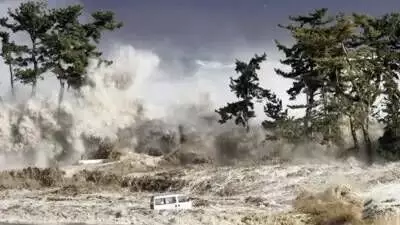Tsunami Threats to U.S. States Heightened by Climate Change and Geology, Warn Scientists
Scientists warn that climate change and regional geology are increasing tsunami risks for U.S. coastal states, urging stronger preparedness and early warning systems.
image for illustrative purpose

A new study from leading scientists reveals alarming projections regarding tsunami risks along the U.S. coastline, emphasizing how climate change and regional geology are exacerbating the threat. As coastal populations grow and climate change accelerates, the risk of devastating tsunamis looms larger than ever.
The study highlights specific U.S. states, including Alaska, California, Oregon, and Washington, as being particularly vulnerable to tsunami events. The seismic activity in these regions, combined with rising sea levels and shifting coastal landscapes, makes them more susceptible to catastrophic tidal waves.
Climate Change and Geology: A Dangerous Combination
The interaction between climate change and regional geology is central to the increasing tsunami risk. As sea levels continue to rise due to global warming, coastal areas are becoming more exposed to the effects of large-scale seismic events. Scientists have also noted that melting glaciers are contributing to more frequent and intense underwater earthquakes, which can trigger tsunamis.
In addition to rising sea levels, increased erosion of coastal cliffs and shifts in tectonic plates are further destabilizing these regions, creating an environment conducive to greater tsunami frequency. These factors are exacerbated by a lack of preparedness in many coastal areas, especially those that have not historically faced large tsunami threats.
Tsunami Hotspots in the U.S.
According to the research, Alaska remains one of the most vulnerable states due to its position along the Pacific Ring of Fire, an area known for frequent seismic activity. Oregon, Washington, and California also face heightened risks due to their proximity to active fault lines, such as the Cascadia Subduction Zone.
The study also warns that while East Coast states like Florida and New York have not traditionally been in the path of tsunamis, they may increasingly experience the effects of such events as climate change contributes to the instability of previously safe zones.
A Call for Preparedness and Action
Scientists stress that preparing for potential tsunami threats should be a priority. "As climate change intensifies and geological shifts occur, we need to invest in early warning systems, infrastructure resilience, and public education," said Dr. Emma Richards, a lead researcher on the study.
Increased funding for tsunami monitoring systems and better coastal management practices are essential in mitigating the impact of these natural disasters. Additionally, local governments are being urged to enhance evacuation plans and update infrastructure to withstand tsunami-induced flooding and erosion.
Looking Ahead
As the climate crisis continues to unfold, scientists warn that the U.S. will need to adapt its approach to disaster preparedness. The increasing frequency and intensity of seismic activity, combined with environmental changes, make the need for robust tsunami defenses more urgent than ever. While significant progress is still required, the findings underscore the pressing need for action to protect coastal communities across the nation from future threats.
Tsunami preparedness has never been more critical, and as the study shows, immediate action could save lives and minimize the catastrophic impact of these natural disasters.

